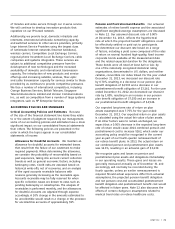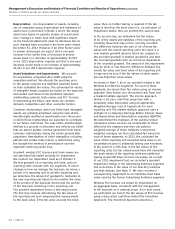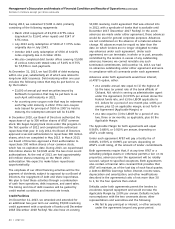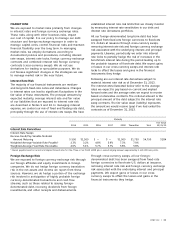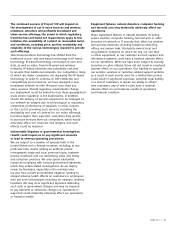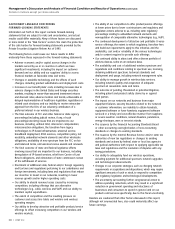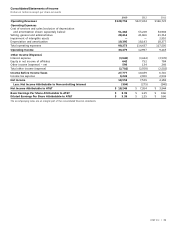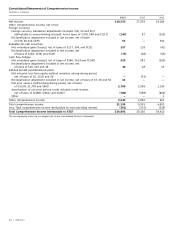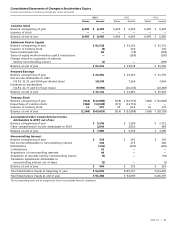AT&T Wireless 2013 Annual Report Download - page 37
Download and view the complete annual report
Please find page 37 of the 2013 AT&T Wireless annual report below. You can navigate through the pages in the report by either clicking on the pages listed below, or by using the keyword search tool below to find specific information within the annual report.
AT&T Inc. | 35
funding of credit lines and other short-term debt obligations,
including commercial paper. These financial institutions also
face new capital-related and other regulations in the
United States and Europe, as well as ongoing legal and
financial issues concerning their loan portfolios, which may
hamper their ability to provide credit or raise the cost of
providing such credit. A company’s cost of borrowing is
also affected by evaluations given by various credit rating
agencies and these agencies have been applying tighter
credit standards when evaluating a company’s debt levels
and future growth prospects. While we have been successful
in continuing to access the credit and fixed income markets
when needed, adverse changes in the financial markets
could render us either unable to access these markets or
able to access these markets only at higher interest costs
and with restrictive financial or other conditions, severely
affecting our business operations.
Changes in available technology could increase
competition and our capital costs.
The telecommunications industry has experienced
rapid changes in the past several years. The development
of wireless, cable and IP technologies has significantly
increased the commercial viability of alternatives to
traditional wireline telephone service and enhanced the
capabilities of wireless networks. In addition, our customers
continue to demand services that can be accessed on
mobile devices, especially video services. In order to remain
competitive, we are deploying a more sophisticated wireline
network and continue to deploy a more sophisticated wireless
network, as well as research other new technologies.
We expect our plans to significantly expand and enhance
our wireless and wireline IP broadband networks will result
in increased capital expenditures and increased debt levels
as these plans are implemented. If the new technologies
we have adopted or on which we have focused our research
efforts fail to be cost-effective and accepted by customers,
our ability to remain competitive could be materially
adversely affected.
Changes to federal, state and foreign government
regulations and decisions in regulatory proceedings
could further increase our operating costs and/or alter
customer perceptions of our operations, which could
materially adversely affect us.
Our wireline subsidiaries are subject to significant federal
and state regulation while many of our competitors are not.
In addition, our subsidiaries and affiliates operating outside
the United States are also subject to the jurisdiction of
national and supranational regulatory authorities in the
market where service is provided. Our wireless subsidiaries
are regulated to varying degrees by the FCC and some state
and local agencies. Adverse rulings by the FCC relating
to broadband issues could impede our ability to manage
anemic economic conditions and technological advances.
Should we fail to respond promptly to address these
changes in customer demands, we are likely to experience
greater pressure on pricing and margins as we continue
to compete for customers who would have even less
discretionary income.
Adverse changes in medical costs and the U.S. securities
markets and a further decline in interest rates could
materially increase our benefit plan costs.
Our costs to provide current benefits and funding for future
benefits are subject to increases, primarily due to continuing
increases in medical and prescription drug costs, and can
be affected by lower returns on funds held by our pension
and other benefit plans, which are reflected in our financial
statements for that year. Investment returns on these funds
depend largely on trends in the U.S. securities markets and
the U.S. economy. We have experienced historically low
interest rates during the last several years. While rates
have increased recently, we expect relatively stable rates
to continue for the next several years. Recent increases in
the rates have led to better than assumed investment
returns on our plan assets and to lower funding obligations.
In calculating the costs included on our financial statements
of providing benefits under our plans, we have made certain
assumptions regarding future investment returns, medical
costs and interest rates. If actual investment returns, medical
costs and interest rates are worse than those previously
assumed, our costs will increase.
The Financial Accounting Standards Board requires companies
to recognize the funded status of defined benefit pension and
postretirement plans as an asset or liability in our statement
of financial position and to recognize changes in that funded
status in the year in which the changes occur. We have
elected to reflect the annual adjustments to the funded status
in our consolidated statement of income. Therefore, an
increase in our costs or adverse market conditions will have
a negative effect on our operating results.
Adverse changes in global financial markets could limit
our ability and our larger customers’ ability to access
capital or increase the cost of capital needed to fund
business operations.
While the global financial markets were stable during 2013,
a continuing uncertainty surrounding global growth rates
has resulted in periodic volatility in the credit, currency,
equity and fixed income markets. Volatility in some areas,
such as in emerging markets, may affect companies’ access
to the credit markets, leading to higher borrowing costs
for companies or, in some cases, the inability of these
companies to fund their ongoing operations. In addition,
we contract with large financial institutions to support our
own treasury operations, including contracts to hedge our
exposure on interest rates and foreign exchange and the


